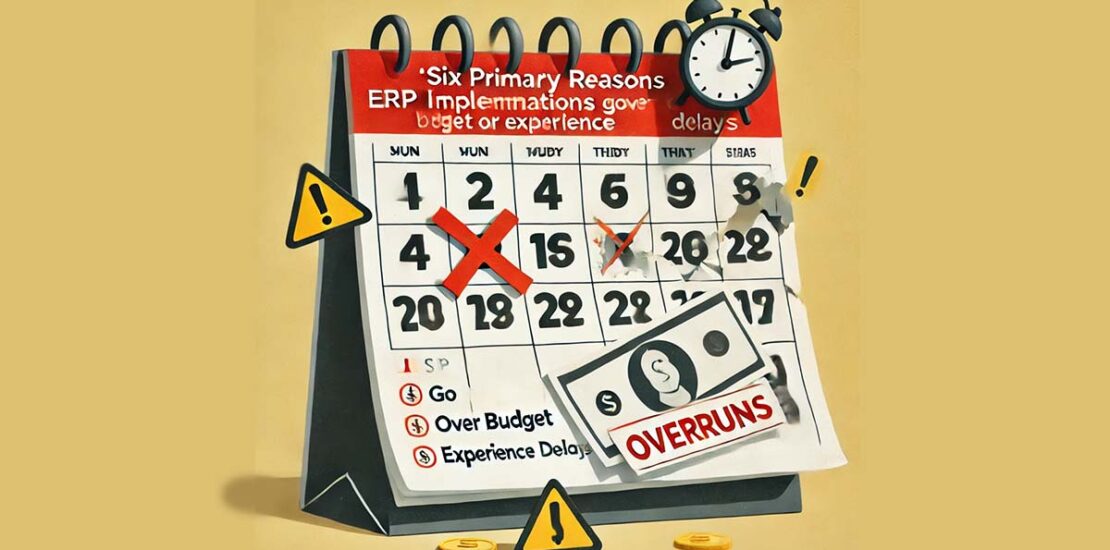Six Primary Reasons ERP Implementations Go Over Budget or Experience Delays
- March 5, 2024
- Posted by: Jeff Andrews
- Categories: ERP, Technology

ERP (Enterprise Resource Planning) systems are transformative for all sizes of businesses and are designed to streamline and manage all the core processes of your business. However, without proper planning and guidance, the implementation will often exceed the initial budget and the go live will be delayed. Understanding the top causes can help you prevent this from happening during your migration.
1. Inadequate Planning and Preparation
The cornerstone of any successful ERP implementation is thorough planning and analysis well before you kick off your project, ideally before you select the solution and an implementation partner. Often, organizations underestimate the complexity and resource requirements of the initiative. It‘s very important to align any ERP plans with your overall business vision and strategy. Adequate analysis of your company’s processes, both current and future state, is essential to develop a realistic budget. Further, a clear systems architecture plan is important to understand integrations needed and planned data movement.
Proper planning will ensure you have:
- key objectives and core requirements
- proper licensing
- realistic timeline
- systems architecture diagrams and plans (for both current state and future state)
- phasing considerations
- internal roles defined (e.g. your internal PM, functional leads)
- team readiness (which includes a skills discussion, a team time commitment plan, and a training plan)
- data migration strategy (which includes an assessment of the state of your current data)
- alignment with your company‘s business strategy
2. Selecting the Wrong System or Implementation Partner
It probably goes without saying that a bad system selection can have costly impacts to your business. Selecting a system that doesn’t align well with your requirements and processes will simply lead to your people becoming frustrated in their jobs and the business having to re-implement another solution in a few years.
In addition to the right solution, you need a consulting partner with knowledge and skills in your industry. Finally, the team they assign to work with you needs to have real-world business experience so they know the questions to ask and how to complete the migration successfully.
3. Scope Creep: The Quiet Cost Inflator
Scope creep, the gradual expansion of the project’s objectives and deliverables, is a common challenge in ERP implementations. As the project progresses, additional features or changes might seem necessary, leading to increased workloads and extended timelines. This unplanned expansion not only inflates costs but can also divert resources from essential tasks, further complicating the project. Usually this is a direct result of poor requirements gathering and prioritization in the planning and analysis phase of the project.
4. Customizing When You Shouldn’t!
All ERP systems must be configured to your requirements. Too often, however, a business wants to keep doing something the same way they’ve always done it, even when it isn’t efficient or a best practice. These ”workarounds“ and customizations commonly require either complex scripting, custom objects and non-standard workflows. The best consultants will know when to steer you in a different direction and when it’s okay to deploy a customization. There’s nothing wrong with customizations, custom objects, custom fields, custom integrations. However, many can lead to expensive updates, challenging maintenance and some standard features of the ERP not working properly. It’s very important to know the difference between a configuration, a low risk customization and a high risk customization.
5. Poor Team and Time Management
An ERP implementation will require quite a bit of time from you and your team even when you’re planning to leverage a third-party for much of the work. As stated earlier, the planning stage should assess your team’s skills as well as their availability during the duration of the project. It’s critical to have a strong, internal project manager who will have their arms around all aspects of the project. They’ll be the driver of deliverables you’re responsible for during the project.
Your functional leaders (e.g. Sales, Operations, Finance, IT leaders) will play a key role in requirements gathering, process decisions, training and overall readiness. You need to outline the time commitment on each team member during each stage of the project so they’re prepared to commit what’s needed. And, you need to coach and watch for proper communication from these leaders to their teams. A functional team with a leader who isn’t on board can quickly cause issues within a project.
6. Training and Change Management Overlooked
If you or your implementation partner view training as a one-time event, you will have a very challenging go live…and likely a rough first few months. Training needs to be conducted in various forms throughout the project. Formal training and proper user acceptance testing (UAT) will help prepare everyone in your business for what should be a welcomed and celebrated change. Depending on the size of your project or the magnitude of the change from your current legacy systems, formal change management planning can help you with people coaching, skills development and internal communications.
A modern ERP can provide significant improvements to visibility, operations, revenue and profit. With the right guidance and proper planning, you can minimize the risks of going over budget and having project delays. If you’d like to learn more about how we help companies in these areas, visit our Services page or reach out using our Contact page.
